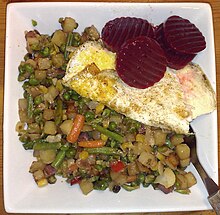Pyttipanna
 A plate of pytt i panne with vegetables, sliced beet, and a fried egg | |
| Alternative names | Biksemad, pytt i panna, pytt i panne, pyttipannu |
|---|---|
| Region or state | Scandinavia |
| Main ingredients | Potatoes, onions, chopped or minced meat |
| Ingredients generally used | Fried egg, pickled beetroot |
Pytt i panne, also pytt i panne,[1] pytt i panne (Norwegian), pyttipannu (Finnish), is a hodgepodge of food similar to a hash. The term is Swedish for "small pieces in pan". It is a popular dish in Sweden, Norway and Finland, and in Denmark, where it bears the name biksemad, literally meaning "mixed food".
Traditionally consisting of potatoes, onions, and any kind of chopped or minced meat such as sausage, ham or meatballs, diced and then pan fried, it is often served with a fried egg, pickled beetroot, sour pickled gherkin, capers and sometimes ketchup or brown sauce.[2] The dish was originally made from leftovers of past meals[1] but now it is far more common to prepare pyttipanna from prime ingredients. Frozen pyttipanna of many varieties can be bought in almost every Swedish, Danish, Norwegian and Finnish supermarket. Many variants of the dish exist, including vegetarian and vegan dishes.
Pyttipanna is often abbreviated to pytt, especially when referring to variants such as oxpytt (pyttipanna made with beef) or krögarpytt. It is occasionally called hänt i veckan ("happened this past week"), reflecting its origin as a dish made with leftovers.[citation needed]
-
Plain pyttipanna without any garnish
Similar dishes
- Bubble and squeak, from England
- Colcannon, from Ireland
- Rumbledethumps, from Scotland
- Trinxat, from the Empordà region of Catalonia, northeast Spain, and Andorra
- Stoemp, from Belgium
- Hash, from the United States
References
- ^ a b Diehl, K.S. (2012). The Everything Nordic Cookbook. F+W Media. p. 199. ISBN 978-1-4405-3282-5. Retrieved January 12, 2017.
- ^ Harding, Paul; Mark Elliott; Steve Kokker; Tom Masters (2007). Scandinavian Europe. Lonely Planet. p. 393. ISBN 978-1-74104-553-6.

